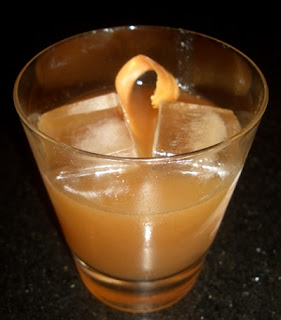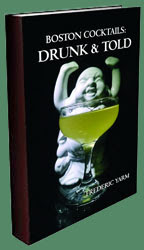Last night I attended a lecture at Harvard University hosted by Dave Arnold, faculty of the French Culinary Institute and one of the bloggers for
Cooking Issues, and Harold McGee, a scientist and author of some seminal books about the chemistry of food and cooking. I had previously heard Dave speak at Tales of the Cocktail's "Science of Shaking" seminar back in 2009 and he did cover some of that material last night. I was familiar Harold McGee through his writing, particularly
On Food & Cooking, and I discussed some of his work in my
notes about eggs post.
Dave started the talk by focusing on juice clarification and carbonation. The process of clarifying fruit juices via agar agar gelling followed by centrifugation (other compounds and processes work well too) removes a lot of the color and cloudiness; with that removal is a loss of flavor including bitterness. For carbonation, clarification of fruit juices is necessary to avoid horrible foaming problems. In a similar rationale, the particulates in citrus juice are necessary to give the desired texture to citrus drinks during shaking. As I will mention in a bit, these particulates can trap air, and removing the particulates can control the gaseous components in the liquid better.
The other process for clarification that was discussed does not require a centrifuge. While Dave encouraged bartenders to own centrifuges, namely a 3 liter scale one with 4 swinging buckets, they can run $8-10,000 new but can be had for $1-2,000 used (or $500-1000 used and broken if you are a fixer-upper type). Instead, there are wine fining technologies that use ionic charges to pick up particulates and precipitate them through gravity alone. Chitosan was one of his preferred compounds; it is made of chitin from the shells of shrimp or other crustaceans and contains multiple positive charges to bind things. In conjunction with Kieselsol which has multiple negative charges, it will strip out these bitter components and particulates in fruit juices without the need of a centrifuge. Dave did say that he was searching for vegetarian options to recommend. Both of these compounds can be bought at wine making shops.
With the topic of carbonating drinks, Dave warned bartenders to drop the alcohol concentration in drinks for two reasons. One is that people generally drink carbonated beverages faster and the other is that carbonation can increase the perception of alcohol which can be unpleasant to some. For carbonation systems, Dave recommended getting a tank and regulator system set to 40 psi; the whole rig can be bought for around $150. The other option is using chargers which can get expensive at 75 cents per tube (versus $15 to fill a large tank) and pricey if multiple carbonation cycles are required. The first part of carbonation should be the removal of air since air is the enemy of carbonation as it encourages foaming. Options are squeezing out (if using a plastic soda bottle system), pulling a vacuum, or adding a blanket of CO2. Multiple rounds of carbonation (upwards of 3-4) will help. In between rounds, the number of nucleation sites for foaming will be depleted. Clarification of fruit juices will help remove many of these nucleation sites as mentioned above. The four points to improve carbonation were: colder, clarification, air removal, multiple rounds of carbonation.
Since carbon dioxide is more soluble in alcohol than in water, more CO2 is needed. Why? Because the tongue cannot detect air in solution but only gases leaving the liquid. For the same feeling on the tongue, there needs to be more gas pressure.
Harold McGee took over as Dave set off to make drinks for the room. Harold spoke about alcohol and the biological purposes for microbes to make it -- namely to poison off competitors from eating their food sources. Most bacteria cannot take more than a percent or two of alcohol save for acetobacter (see the
notes about shrubs post). Next, Harold moved on to the strange chemical qualities of ethanol as compared to water and how much stranger things get when the two are mixed. The first demonstration was mixing 250 mL of water with 250 mL of ethanol. Both started at room temperature of 21.4°C, but after mixing, the volumes were less than the expected 500 mL (closer to 490 mL) and warmer than expected at 27.9°C. While diluting liquor warms it up, Harold assured the room that the cooling effect of ice would easily make this change negligible. In a chart of the various difference of the density, boiling and melting points, and the like of water and ethanol, Harold focused on two important differences: vapor pressure and surface tension. Ethanol has a higher vapor pressure meaning that it wants to leave as a gas more, and water has a higher surface tension meaning it is attracted more to other water molecules (great molecular stickiness). With these differences along with boiling point, distillation can be achieved.
When water and alcohol are mixed, there are other changes besides volume and temperature. First, the mixture becomes much more viscous than either of the starting components such that it gives a greater mouthfeel. Relating to the volume differences, the minimum occurs at 80% alcohol due to how the alcohol interacts with the water molecules. The hydrophobic end of ethanol molecules will interact and fill the holes in between water molecules and will increase the efficiency of molecular packing. Things got a bit technical with nuclear magnetic resonance data showing the different ways ethanol and water can interact (3E-H2O and E-6H2O), and Harold commented that some people believe that these difference affect vodka flavor. The impurities would effect which interactions are favored and can affect mouthfeel and flavor.
In terms of aroma, alcohol molecules can cluster aroma molecules via ethanol's hydrophobic end. This process isolates these molecules and protects them from our senses. In diluting the spirits, the ethanol concentration drops and these aroma molecules are less happy in aqueous solution and volatize so we can detect them.
Dave took over with the science of shaking versus stirring. For a detailed explanation, I will direct you to one of his
articles. The main points are:
• 99% of chilling power of ice comes from the melting process; initial temperature of the ice matters less.
• There is no cooling without dilution, and no dilution without cooling (assuming the ice is in the drink).
• The more water that is trapped in crenulations in wet ice, the more dilution there will be without cooling. "Crap ice" from a machine will work just as well if the trapped liquid water is stripped away.
• Ethanol helps to drop the freezing point of the solution so sub-0°C/32°F temperatures are possible.
• Ice size in shaking does not matter as all equilibrates in terms of dilution and chilling in around 12 seconds. All styles fall with in a 1-2° range.
• More important than shaking technique is straining technique. The amount of ice shards that pass through will effect temperature and dilution.
• Stirring is less efficient so ice size matters.
• To get consistency in stirred drinks, the time, size of ice, rate of stirring matter greatly.
• Stirring produces warmer but less diluted drinks than shaking.
• While liquid nitrogen can cool down drinks, it is harder to use on a small scale. If used, adding it to the glass first will allow better mixing. Adding it after, and the liquid nitrogen will remain on the surface more.
• Liquid nitrogen is great for chilling glassware though (see my 3 part series on the effect of glass temperature on the drink for why cold glassware is important).
There was a demonstration on the effect of red hot pokers to make Colonial era drinks using a high proof spirit and a low proof one like beer, cider, or wine (in addition to sugar and perhaps a citrus element and salt). Instead of giving great details, please see these two New York Times articles about the
red hot poker and
recipes (including the stove top version). Additional notes are as follows:
• The basic premise behind the process was taking one molecule (sugar) without an aroma and converting it into hundreds or thousands of molecules, some of which have aromas.
• As things are heated, they get more bitter and burnt so more sugar is needed to compensate.
• Remember to lower the alcohol concentration for heat increases our detection of alcohol.
• Hot drinks are better served in a wide bowl like a tea cup to dissipate the alcohol aroma better. Irish Coffee mugs are too narrow and concentrate stinging alcohol aromas.
The last part was about emulsifiers and stabilizers to make oil-based simple syrups. Instead of fat washing which can capture a subset of the flavor components, this process captures them all as well as including the rich mouthfeel of the fats and oils. Gum arabic helps to emulsify oils and xanthan gum prevents these oil droplets from coalescing. The combination can be found in Tic Gums products like their 301S product. Using these in conjunction with a stick blender will allow oils to be put into syrups and buttered rums from having the fat float to the surface. As a demonstration, Dave and Harold made a drink using a pumpkin seed oil syrup; for every 1 1/2 oz, there was 1 oz of 1:1 simple syrup and 1/2 oz oil, and this added a glorious flavor and thickness to the drink.
Dave ended the talk by giving a big hint for drink creators. If a drink tastes flat, try adding a pinch of salt before you sink it in frustration.
 2/3 Rye Whiskey (2 oz Ryan & Wood)
2/3 Rye Whiskey (2 oz Ryan & Wood)














 1 oz Cocchi Americano
1 oz Cocchi Americano

 This month's
This month's 






 1 1/2 oz Four Roses Bourbon
1 1/2 oz Four Roses Bourbon









 the incorporation of fire was indeed a plus. Since I was out at the No. 3 Gin event that night (although I did catch the tail end of the TDN event when I returned home), I prepared my recipe in advance and emailed it to SeanMike of Scofflaw's Den to post.
the incorporation of fire was indeed a plus. Since I was out at the No. 3 Gin event that night (although I did catch the tail end of the TDN event when I returned home), I prepared my recipe in advance and emailed it to SeanMike of Scofflaw's Den to post.










 The 2017 collection of 855 drink recipes, bartender tributes, and essays on hospitality from CocktailVirgin's Frederic Yarm. Available at
The 2017 collection of 855 drink recipes, bartender tributes, and essays on hospitality from CocktailVirgin's Frederic Yarm. Available at  The 2012 collection of 505 drink recipes, techniques, and Boston bar recommendations from Frederic Yarm. Available at
The 2012 collection of 505 drink recipes, techniques, and Boston bar recommendations from Frederic Yarm. Available at 



